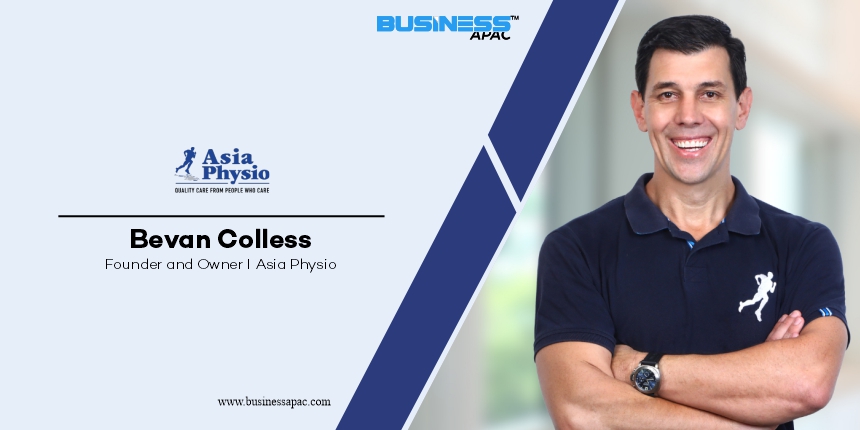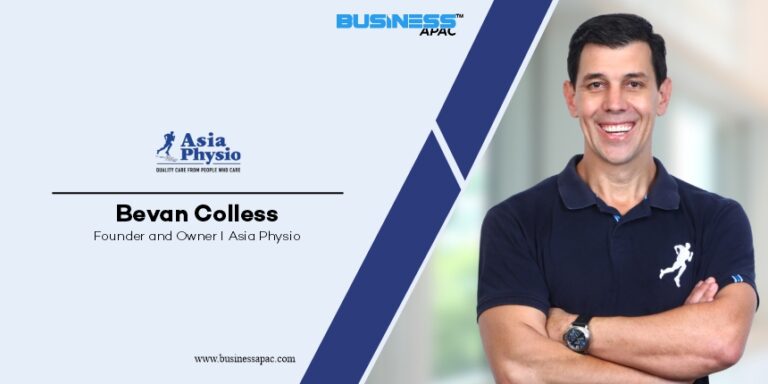There is a certain kind of person who, upon deciding to start a business in a foreign country, would write a detailed plan, secure a location, and then, only when every variable is accounted for, arrange for the necessary equipment. Bevan Colless is not that kind of person. In 2002, he and his wife decided to open a physiotherapy clinic in Tokyo. Before they had a lease, before they had a registered address, before they even had a firm opening date, they packed a shipping container full of treatment beds and exercise equipment and sent it on a slow boat to the port of Yokohama. It was an act of audacious, calculated faith, a strategic gamble that perfectly encapsulates the man himself: part visionary, part systems integrator, part competitive sportsman who understands that sometimes, the only way to win is to commit to the play before the field is even set.
That container, sailing across the ocean toward an unknown destination, was the physical manifestation of a business philosophy that has allowed Bevan to grow his practice from a two-person, ‘husband and wife operation’ into Asia Physio, a network of 12 clinics with over 100 staff spread across Japan and Singapore. He is a man who thinks in systems, who thrives on competition, and who has weathered storms that would have shipwrecked most entrepreneurs. His story is not just one of success, but of survival, adaptation, and the relentless drive to build something that lasts, a lesson in how the principles of sport and the precision of a scientist can forge a resilient and deeply human enterprise.
The Competitor’s Genesis
Bevan’s journey began not with a passion for physiotherapy, but with a degree in Sports Science and a deep curiosity about the world. He moved to Japan in 1994, spending two years working a collection of jobs in Tokyo, including track and field coach and relief PE teacher. It was there, in the dynamic intersection of athletics and instruction, that a new path began to reveal itself. He found he enjoyed the focused, one-to-one interaction with an athlete far more than commanding a classroom. He wanted a profession where he could work for himself, a field where his interventions could have a direct and measurable impact. He decided on physiotherapy and returned to Australia to study at the University of Sydney from 1996 to 1999.
It was there Bevan met his wife, and during a three-month university holiday, he brought her to Japan. She fell in love with the country just as he had. The plan began to form: after graduation, they would return to Tokyo to open their own clinic. The universe, it seems, rewards a clear intention. A friend told them that the primary physiotherapist for the expatriate community in Tokyo, a trailing spouse, was leaving as her husband was being transferred. The gap in the market was not just an opportunity; it was a starting pistol.
This is the moment that reveals the strategic mind behind the bold action. Hearing the news, Bevan and his wife did not hesitate. They bought the departing physio’s small business to begin with some momentum, and with a breathtaking leap of faith, they sent their container of equipment on its way. The clock was now ticking. They flew to Tokyo with a singular, urgent mission: find a place to open their clinic before a literal ship full of their ambitions arrived in port. Luckily, they did.
The Integrator’s Blueprint
For many, that initial, high-stakes scramble would be the defining story of their business. For Bevan, it was just the first play in a much longer game. Over the next two decades, Asia Physio methodically expanded its footprint, opening clinics in the snowy ski fields of Japan, the tropical climes of Singapore, and the idyllic shores of Okinawa. The business model evolved, offering more specialized services with expert physiotherapists in women’s health, pediatrics, sports injuries, and spinal conditions. They diversified into pilates and sports massage, and are now on the cusp of opening a full-fledged recovery center.
This kind of growth is not accidental. It is engineered. Bevan, an entrepreneur who is always analyzing businesses and thinking of new ones, has a mind built for this. He and his team have adopted the Entrepreneurial Operating System (EOS), a framework that clarifies roles with stark precision. In this system, Bevan occupies two key seats: the Visionary and the Integrator. “I need to come up with ideas for the business, which for me is the easy part,” Bevan explains, “but also as the integrator, be responsible for execution.”
It is this duality that defines Bevan’s leadership. He is the restless innovator, the one dreaming up new ventures like a Niseko recovery center complete with red light therapy, hyperbaric oxygen chambers, and cryotherapy. Yet, he is also the grounded operator who runs the weekly leadership team meetings with a focus on accountability and results. He looks forward to these meetings, just as he does the fortnightly all-hands meetings, which serve to keep his geographically scattered team of over 100 people aligned and moving toward a common goal. His quarterly conversations with his direct reports are a crucial feedback loop, ensuring he knows how his staff are feeling and can address their concerns. “I see most of my role in making the team feel good and keeping everyone motivated,” Bevan says, a simple statement that belies the complex architecture required to achieve it.
This architecture is visible in the very structure of the patient experience. Bevan encourages a two therapist system, where a patient works between two physios. “It ensures they have two minds on the case,” he notes, “and also ties the patient to the clinic rather than the therapist.” It is a clever, subtle strategy that builds institutional loyalty and prevents the siloing of knowledge. The culture is further strengthened by only having employees, rather than renting space to independent contractors, and through regular social and educational events that help people feel connected, even if they have never met in person.
The Crucible of Crisis
Every leader is eventually tested, and Bevan’s trial by fire comes in December 2019. High on the success of their Niseko ski clinic, they signed a three-year lease on a prime piece of real estate in the center of town. It was a mid-six-figure commitment, and the fit-out was another huge expense. Two months later, the world shut down. COVID hit, and for the next two years and ten months of that very expensive lease, they had virtually zero income.
The hits kept coming. They were asked to leave their location in Hakuba. While locked out of Singapore, a key staff member they had recruited from abroad attempted to set up a competing clinic, trying to poach their entire team. “We were looking at bankruptcy and going back to live with my parents,” Bevan admits with stark honesty.
This is where the cool headed competitor and the pragmatic integrator took over. He describes the brutal triage that followed. “You need to line up your debtors and prioritize who needs to be paid first,” Bevan says. The wages were always at the top of the list. He speaks of the immense stress of owing people money, of knowing people are angry at you for paying them late. “It is tough, and a skill in itself,” he reflects. “It may make you a bit cold.” It is a raw and humbling admission from a leader who is more accustomed to discussing growth than survival. But they got through it. In the end, everyone was paid in full, and the business is now, as Bevan says, “back firing on all cylinders.”
The Buzz of the Big Day
When asked about his proudest milestones, Bevan is circumspect. Opening a new clinic brings congratulations, but he knows that is the easy part; the hard part is making it successful. What truly animates him is the human energy of his enterprise. He still loves the buzz of the ski clinics, especially in early December when a hundred new and returning staff descend for the season. “It’s like the wedding you’ve been planning for all year, and finally it’s the big day,” he says. The atmosphere at the season-opening party, he describes, is “supercharged,” a special night fueled by excitement and shared purpose.
Professionally, Bevan is energized by being at the forefront of new clinical developments. He speaks with passion about the new understanding of ACL healing and the revolutionary Cross Bracing protocol, a new frontier where his team has been heavily involved. The knowledge that the management a person receives in the first two weeks after an ACL tear can be life-changing gives his work a profound sense of impact.
This intense focus has been a defining characteristic of his life. Bevan and his wife spent a decade obsessed with triathlon, each completing over 20 Ironman races and competing in the Hawaii Ironman multiple times. During that period, he admits, they were not super focused on the business. “I find balance hard,” he confesses, “and not sure it’s in me.” After they stopped competing in 2015, they turned that same all-in energy toward the business and their daughter, who was born in 2016. He still finds time for exercise classes and bike rides, and is an avid follower of Australian rugby and cricket.
As Bevan looks to the future, the visionary is clearly back in the driver’s seat. The Niseko recovery center is launching telehealth prescriptions with a registered Japanese sports doctor are becoming available, and ties with the US military in Okinawa and Tokyo are strengthening. The game continues. For a man who sees business as the sport of life, there is always another play to make, another strategy to execute. Yet, when asked for a final piece of wisdom, his leadership philosophy boils down to a simple, humble truth. “Keep your staff happy,” Bevan says, “and they will keep your customers happy.” It is the quiet, foundational wisdom of a leader who knows that no matter how brilliant the strategy or how bold the risk, an enterprise is, in the end, a profoundly human endeavor.
Quotes
“Keep your staff happy and they will keep your customers happy.”
“You need to be prepared to take a risk and deal with the associated stress.”
Also Read: Shaping Tomorrow’s Healthcare: The Visionary Leaders of 2025










